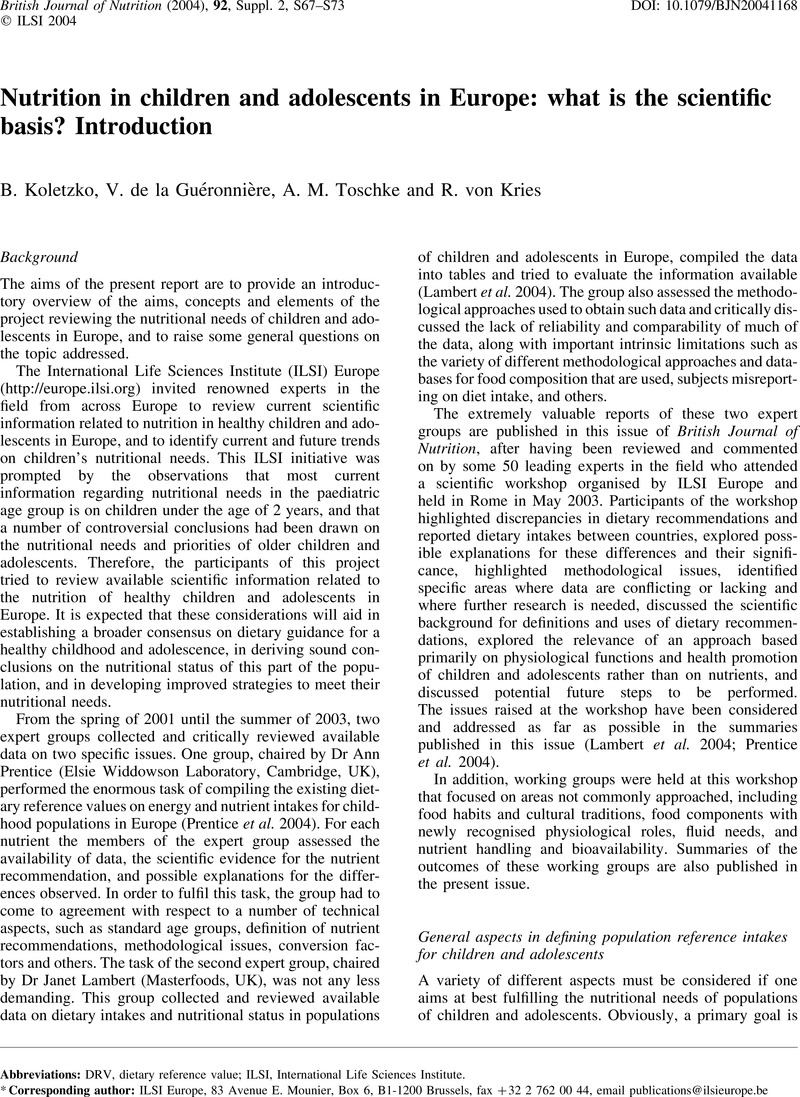Crossref Citations
This article has been cited by the following publications. This list is generated based on data provided by Crossref.
Song, YoonJu
Joung, Hyojee
Engelhardt, Katrin
Yoo, Sun Young
and
Paik, Hee Young
2005.
Traditionalv.modified dietary patterns and their influence on adolescents' nutritional profile.
British Journal of Nutrition,
Vol. 93,
Issue. 6,
p.
943.
Koletzko, Berthold
Broekaert, Ilse
Demmelmair, Hans
Franke, Jeanette
Hannibal, Iris
Oberle, Doris
Schiess, Sonja
Baumann, Blanca Troy
and
Verwied-Jorky, Sabine
2005.
Early Nutrition and its Later Consequences: New Opportunities.
Vol. 569,
Issue. ,
p.
69.
Kosti, Rena I.
and
Panagiotakos, Demosthenes B.
2006.
The Epidemic of Obesity in Children and Adolescents in the World.
Central European Journal of Public Health,
Vol. 14,
Issue. 4,
p.
151.
Han, Hee Youn
Hee, Chang Joo
Shim, Hae Sun
Hong, Young Jin
Son, Byong Kwan
Kim, Hwan Cheol
and
Kim, Soon Ki
2006.
The iron status and the relationship between iron deficiency and body mass index in middle school girls.
Korean Journal of Pediatrics,
Vol. 49,
Issue. 11,
p.
1174.
Komlos, John
and
Lauderdale, Benjamin E.
2007.
The mysterious trend in American heights in the 20th century.
Annals of Human Biology,
Vol. 34,
Issue. 2,
p.
206.
Atkinson, Stephanie A.
and
Koletzko, Berthold
2007.
Determining Life-Stage Groups and Extrapolating Nutrient Intake Values (NIVs).
Food and Nutrition Bulletin,
Vol. 28,
Issue. 1_suppl1,
p.
S61.
Kersting, M
Sichert-Hellert, W
Vereecken, C A
Diehl, J
Béghin, L
De Henauw, S
Grammatikaki, E
Manios, Y
Mesana, M I
Papadaki, A
Phillipp, K
Plada, M
Poortvliet, E
and
Sette, S
2008.
Food and nutrient intake, nutritional knowledge and diet-related attitudes in European adolescents.
International Journal of Obesity,
Vol. 32,
Issue. S5,
p.
S35.
Vereecken, C A
Covents, M
Sichert-Hellert, W
Alvira, J M F
Le Donne, C
De Henauw, S
De Vriendt, T
Phillipp, M K
Béghin, L
Manios, Y
Hallström, L
Poortvliet, E
Matthys, C
Plada, M
Nagy, E
and
Moreno, L A
2008.
Development and evaluation of a self-administered computerized 24-h dietary recall method for adolescents in Europe.
International Journal of Obesity,
Vol. 32,
Issue. S5,
p.
S26.
Brug, Johannes
Tak, Nannah I.
te Velde, Saskia J.
Bere, Elling
and
de Bourdeaudhuij, Ilse
2008.
Taste preferences, liking and other factors related to fruit and vegetable intakes among schoolchildren: results from observational studies.
British Journal of Nutrition,
Vol. 99,
Issue. S1,
p.
S7.
Koletzko, Berthold
von Kries, Rüdiger
Monasterolo, Ricardo Closa
Subías, Joaquín Escribano
Scaglioni, Silvia
Giovannini, Marcello
Beyer, Jeannette
Demmelmair, Hans
Anton, Brigitte
Gruszfeld, Dariusz
Dobrzanska, Anna
Sengier, Anne
Langhendries, Jean-Paul
Rolland Cachera, Marie-Francoise
and
Grote, Veit
2009.
Can infant feeding choices modulate later obesity risk?.
The American Journal of Clinical Nutrition,
Vol. 89,
Issue. 5,
p.
1502S.
Koletzko, B.
von Kries, R.
Monasterolo, R. C.
Subias, J. E.
Scaglioni, S.
Giovannini, M.
Beyer, J.
Demmelmair, H.
Anton, B.
Gruszfeld, D.
Dobrzanska, A.
Sengier, A.
Langhendries, J. P.
Cachera, Marie-Françoise Rolland
and
Grote, V.
2009.
Early Nutrition Programming and Health Outcomes in Later Life.
Vol. 646,
Issue. ,
p.
15.
Bouman, Martine P. A.
and
Brown, William J.
2010.
Ethical Approaches to Lifestyle Campaigns.
Journal of Mass Media Ethics,
Vol. 25,
Issue. 1,
p.
34.
Hong, Heeok
and
Lee, Jung Sug
2010.
The Relationship between Food and Nutrient Intakes, Glycemic Index, Glycemic Load, and Body Mass Index among High School Girls in Seoul.
The Korean Journal of Nutrition,
Vol. 43,
Issue. 5,
p.
500.
Koletzko, Berthold
and
Toschke, André Michael
2010.
Meal Patterns and Frequencies: Do They Affect Body Weight in Children and Adolescents?.
Critical Reviews in Food Science and Nutrition,
Vol. 50,
Issue. 2,
p.
100.
Kobe, Helena
Štimec, Matevž
Ribič, Cirila Hlastan
and
Fidler Mis, Nataša
2012.
Food intake in Slovenian adolescents and adherence to the Optimized Mixed Diet: a nationally representative study.
Public Health Nutrition,
Vol. 15,
Issue. 4,
p.
600.
de Luca, A.
2017.
Requerimientos nutricionales del adolescente.
EMC - Pediatría,
Vol. 52,
Issue. 2,
p.
1.
de Luca, A.
2019.
Besoins nutritionnels de l’adolescent.
Journal de Pédiatrie et de Puériculture,
Vol. 32,
Issue. 4,
p.
171.
Moore Heslin, Aoibhín
and
McNulty, Breige
2023.
Adolescent nutrition and health: characteristics, risk factors and opportunities of an overlooked life stage.
Proceedings of the Nutrition Society,
Vol. 82,
Issue. 2,
p.
142.
De Luca, A.
2024.
Requerimientos nutricionales del adolescente.
EMC - Pediatría,
Vol. 59,
Issue. 4,
p.
1.



